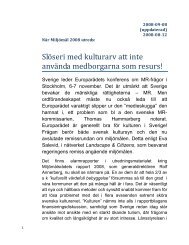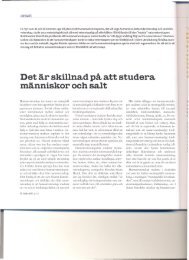Landscape through literature Le paysage à travers la littérature
Landscape through literature Le paysage à travers la littérature
Landscape through literature Le paysage à travers la littérature
Create successful ePaper yourself
Turn your PDF publications into a flip-book with our unique Google optimized e-Paper software.
La harpe du vent<br />
Pour Patrick Collins<br />
<strong>Le</strong>s sons d’Ir<strong>la</strong>nde,<br />
Ce chuchotement incessant<br />
qui ne vous quitte jamais,<br />
qui filtre des<br />
petits buissons et de l’herbe,<br />
de <strong>la</strong> bruyère et des fougères,<br />
des mares ridées des tourbières,<br />
des branches d’arbre griffues,<br />
des amas légers de nuages,<br />
vue légère de sons,<br />
une main sans cesse<br />
peignant et caressant<br />
le <strong>paysage</strong>, jusqu’<strong>à</strong> ce que<br />
<strong>la</strong> vallée luise<br />
comme le pommeau sur<br />
le manteau d’un poney de montagne.<br />
Traduction: Conseil de l’Europe, 2005.<br />
John FEEHAN,<br />
born / né en 1946<br />
The future <strong>la</strong>ndscape:<br />
a blueprint for conservation<br />
This <strong>la</strong>nd of Laois, is, in the <strong>la</strong>st analysis, our one, our<br />
ultimate resource. For eight thousand years now it has<br />
supported human communities, producing food to<br />
nourish, materials to shelter and clothe: a p<strong>la</strong>ce to call<br />
home. The <strong>la</strong>ndscape of Laois itself is a rich tapestry<br />
recording the interp<strong>la</strong>y over these eight thousand years<br />
of its natural heritage and human progress. […]<br />
The ultimate aim of conservation is the preservation<br />
and cultivation in the <strong>la</strong>ndscape that forms the context<br />
of our common life of all the richness and diversity it<br />
possesses for the enrichment of our own human spirit.<br />
In more concrete terms, it means the retention of all<br />
features of archaeological and historical importance,<br />
or of architectural or artistic merit; it means the preservation<br />
of the surviving fragments of primary habitats<br />
in the county: primary wood<strong>la</strong>nd and wet<strong>la</strong>nd, with all<br />
their varied life-forms, in particu<strong>la</strong>r: habitats we can<br />
never rep<strong>la</strong>ce when they are destroyed. It means the<br />
maintenance as far as possible of continuity where<br />
change is inevitable, and the encouragement and<br />
preservation of natural diversity, and a human <strong>la</strong>nduse<br />
fabric in harmony with the natural <strong>la</strong>ndscape. […]<br />
The <strong>la</strong>ndscape is an open book. From an educational<br />
viewpoint it is a resource book of incomparable richness,<br />
though we have been accustomed to consult only<br />
a few pages. It belongs to all of us, and it cannot survive<br />
unless all of us care, because particu<strong>la</strong>r pages are in<br />
the keeping of individuals who may not understand<br />
what they possess. There has often been little enough<br />
leisure time to stand in the fields and look about us. We<br />
have been busy about many urgent tasks, without the<br />
time or the inclination to sit at the feet of the teaching<br />
<strong>la</strong>nd. There has also been a failure in education: for<br />
we were not taught to look, to see and understand what<br />
is about us, so that we might come to an awareness of<br />
why it is important that the diversity of the <strong>la</strong>nd should<br />
remain safe in our keeping.<br />
<strong>Le</strong> <strong>paysage</strong> de demain:<br />
projet de conservation<br />
Cette terre du comté de Laois est, en dernière analyse,<br />
notre seule, notre ultime ressource. Depuis maintenant<br />
huit mille ans, elle abrite les communautés humaines,<br />
leur apportant ce qu’il faut pour manger, se loger et<br />
se vêtir: un foyer. En soi, le <strong>paysage</strong> du Laois est une<br />
riche tapisserie qui raconte l’interaction, durant ces<br />
huit mille ans, entre son patrimoine naturel et les progrès<br />
de l’homme. […]<br />
<strong>Le</strong> but ultime de <strong>la</strong> conservation, c’est de préserver et<br />
de cultiver, dans le <strong>paysage</strong> qui forme le contexte de<br />
notre vie commune, toute <strong>la</strong> richesse et <strong>la</strong> diversité qu’il<br />
possède aux fins d’enrichissement de notre propre<br />
esprit humain. Plus concrètement, il s’agit de garder tous<br />
les traits d’importance archéologique et historique ou<br />
d’intérêt architectural ou artistique; de préserver les<br />
fragments subsistant des habitats primitifs du pays:<br />
bois et marais primaires, avec toute <strong>la</strong> variété de leurs<br />
formes vivantes, en particulier, les habitats qui, une<br />
fois détruits, sont <strong>à</strong> jamais irremp<strong>la</strong>çables. Il s’agit de<br />
maintenir, autant que faire se peut, <strong>la</strong> continuité l<strong>à</strong> où<br />
les changements sont inévitables, d’encourager et de<br />
préserver <strong>la</strong> diversité naturelle; de fabriquer un tissu<br />
humain d’utilisation de <strong>la</strong> terre en harmonie avec le<br />
<strong>paysage</strong> naturel. […]<br />
<strong>Le</strong> <strong>paysage</strong> est un livre ouvert. D’un point de vue<br />
éducatif, il est une ressource documentaire d’une incomparable<br />
richesse, même si nous avons été habitués <strong>à</strong><br />
n’en consulter que quelques pages. Il nous appartient<br />
<strong>à</strong> tous et il ne peut survivre sans notre vigi<strong>la</strong>nce <strong>à</strong> tous,<br />
car certaines pages sont confiées <strong>à</strong> <strong>la</strong> garde de<br />
personnes qui risquent de ne pas comprendre ce qu’elles<br />
possèdent. Souvent, nous avons passé trop peu de<br />
temps <strong>à</strong> rester dans les champs <strong>à</strong> regarder autour de<br />
nous. Nous nous sommes occupés <strong>à</strong> de multiples tâches<br />
urgentes, sans le temps ou l’envie de nous asseoir au<br />
pied de cette terre qui nous enseigne. Sans compter une<br />
<strong>la</strong>cune de l’éducation: on ne nous a pas appris <strong>à</strong><br />
regarder, <strong>à</strong> voir et <strong>à</strong> comprendre ce qui nous entoure,<br />
de manière <strong>à</strong> ce que nous puissions arriver <strong>à</strong> savoir<br />
pourquoi il est important que <strong>la</strong> diversité de <strong>la</strong> terre<br />
demeure en sûreté sous notre garde.<br />
Traduction: Conseil de l’Europe, 2005.<br />
n a t u r o p a n o 1 0 3 / 2 0 0 5 43





